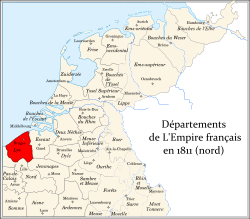Department of Lys | |||||||||
|---|---|---|---|---|---|---|---|---|---|
| 1795–1814 | |||||||||
 Location of Lys in France (1812) | |||||||||
| Status | Department of the French First Republic and French First Empire | ||||||||
| Chef-lieu | Bruges 51°12′N3°13′E / 51.200°N 3.217°E | ||||||||
| Official languages | French | ||||||||
| Common languages | Dutch | ||||||||
| History | |||||||||
• Creation | 1 October 1795 | ||||||||
• Treaty of Paris, disestablished | 30 May 1814 | ||||||||
| Population | |||||||||
• 1784 [1] | 444,260 | ||||||||
• 1804 [1] | 461,659 | ||||||||
• 1805 [2] | 471,689 | ||||||||
• 1812 [3] | 491,143 | ||||||||
| |||||||||
| Today part of | |||||||||
Lys (French: [lis] , Dutch : Leie) was a department of the French First Republic and French First Empire in present-day Belgium. It was named after the river Lys (Leie). It was created on 1 October 1795, when the Austrian Netherlands and the Prince-Bishopric of Liège were officially annexed by the French Republic. [4] Prior to this annexation, its territory was part of the County of Flanders. Its Chef-lieu was Bruges.
Contents
- Administration
- Prefects
- General Secretaries
- Subprefects of Bruges
- Subprefects of Courtray
- Subprefects of Furnes
- Subprefects of Ypres
- References

The department was subdivided into the following four arrondissements and cantons (as of 1812): [3]
- Bruges: Ardoye, Bruges (5 cantons), Ghistelles, Ostende, Ruysselede, Thielt and Thourout (2 cantons).
- Courtray: Avelghem, Courtray (4 cantons), Haerelbeke, Ingelmunster, Menin, Meulebeke, Moozeele, Oost-roosebeke and Roulers.
- Furnes: Dixmude, Furnes, Haeringhe and Nieuport.
- Ypres: Elverdinge, Hooglede, Messines, Pashendaele, Poperinghe, Wervicq and Ypres (2 cantons).
After Napoleon was defeated in 1814, the department became part of the United Kingdom of the Netherlands. Its territory corresponded perfectly with the present-day Belgian province of West Flanders.